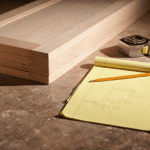
The mere mention of woodworking often evokes images of a seasoned craftsman, meticulously shaping pieces in a dusty workshop. For centuries, this craft has remained largely unchanged. However, as the world progresses, so does the realm of woodworking. By examining current patterns and projecting future shifts, we can forecast an exciting future for this time-honored craft. In this article, we’ll explore ten anticipated trends and innovations that may redefine woodworking in the coming years.
Digital Design and Computer-Aided Production
Today, Computer-Aided Design (CAD) tools are becoming increasingly commonplace in woodworking shops. The rise of digital design means a transition from traditional drafting and sketching to intricate, 3D models that can be adjusted with a click. Beyond design, Computer Numerical Control (CNC) machines—machines guided by CAD inputs—allow for precision cutting, carving, and assembly. Expect more workshops to integrate these digital tools, fostering creativity and precision like never before.
Eco-friendly Materials and Practices
With a growing emphasis on sustainability, woodworking will naturally shift towards more environmentally-friendly practices. This may include using reclaimed or recycled wood, adopting non-toxic finishes and glues, or even exploring alternative wood-like materials such as bamboo. As consumers increasingly seek sustainable products, woodworkers will likely prioritize eco-friendly sources and methods.
Smart Furniture with Built-In Technology
As our homes get smarter, the furniture within them must evolve. Future woodcrafts might integrate wireless charging pads, embedded LED lights, or even sensors to detect and respond to the environment. Imagine a wooden desk that can adjust its height based on your posture or a cabinet that changes its internal temperature. The fusion of technology and traditional woodworking will create functional, futuristic furniture pieces.
Enhanced Safety with Automation and Robotics
Accidents in woodworking, sadly, are all too common. But, as robotics and automation technologies advance, we can anticipate safer woodworking environments. Robotic arms might handle the more dangerous tasks, while automated systems could monitor workshop conditions to ensure safety standards. These innovations won’t replace the woodworker but will act as assistants, ensuring the craft is both safer and more efficient.

Personalized and Customizable Creations
In our era of customization, the desire for unique, personalized items is growing. Advanced machinery and design software will enable woodworkers to cater to bespoke requests more efficiently. From custom engravings to intricate designs tailored to individual preferences, the future of woodworking will be as unique as each of its customers.
Virtual Reality (VR) and Augmented Reality (AR) in Woodworking
While VR and AR are often associated with gaming or entertainment, they hold significant potential for woodworking. Designers might use VR to visualize and tweak their creations in a virtual space before actual production. Meanwhile, AR can assist in the assembly process, overlaying digital guides on real-world components, ensuring pieces fit perfectly. Such immersive technologies can transform the way woodworkers design, assemble, and even learn their craft.
Adaptive Learning and Online Workshops
The digital age has brought forth an explosion of online learning platforms. In the future, woodworking enthusiasts, whether beginners or experts, can access courses, tutorials, and workshops from the world’s best craftsmen without leaving their homes. These platforms might employ AI-driven tools to adapt content according to a learner’s progress, offering a personalized learning curve. Moreover, interactive forums and online communities will enable woodworkers worldwide to collaborate, share, and innovate.
Wearable Tech for Efficiency and Precision
Imagine wearing smart gloves that vibrate when you’re holding a tool at the wrong angle, or glasses that display measurements and guidelines as you work. Wearable technology will augment a woodworker’s natural skills, allowing for enhanced precision and efficiency. These wearables can also monitor physical health, ensuring ergonomic practices and alerting users if they adopt potentially harmful postures or techniques.
Biodegradable and Transient Wood Products
As the world grapples with waste and the impermanence of products, the woodworking industry might shift focus towards creating transient or biodegradable items. Such products, designed for shorter lifespans, would degrade without leaving harmful residues. This would particularly appeal to a market segment conscious about reducing their environmental footprint, and could range from temporary installations to transient home furnishings.

3D Printing with Wood Filaments
3D printing is revolutionizing many industries, and woodworking is no exception. The development of wood filaments—made from a mixture of wood fibers and polymers—allows woodworkers to 3D print intricate designs that might be challenging or time-consuming to carve traditionally. This doesn’t mean replacing traditional techniques, but instead, it offers an additional tool in the woodworker’s arsenal. Combining 3D printed components with handcrafted elements will provide a blend of efficiency and authenticity.
Conclusion
The future of woodworking is not just about wood. It’s about melding tradition with technology, handcrafted artistry with machine precision, and sustainable sources with innovative practices. While the essence of woodworking—the transformation of raw material into something functional and beautiful—will remain, the ways in which this transformation occurs will undoubtedly evolve. As woodworkers embrace these trends and innovations, they not only ensure the longevity of their craft but also elevate it to unprecedented heights. The next chapter in woodworking’s long history promises to be its most thrilling yet.






